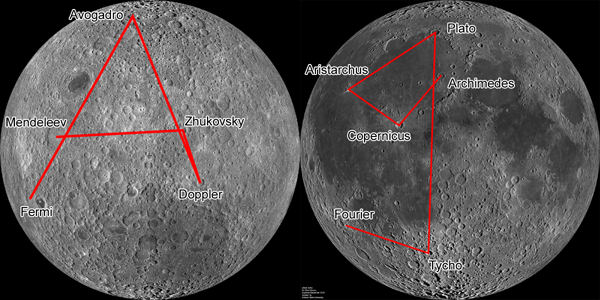
CISRA Puzzle Competition 2012 - Solutions
3A. Scintillant Sparkler
Each of the clues refers somewhat obtusely to a scientist or philosopher:
Italian irradiation initiator inventor - Enrico Fermi, Italian-born scientist who built the first atomic fission reactor pile.
Differing diffuse damp division determiner - Amadeo Avogadro, who formulated Avogadro's Law about the molecular composition of gases. ("Damp" here is used in the meaning that is synonymous with gas.)
Austrian astronomer and audio accent alteration accounter - Christian Doppler, Austrian scientist who studied binary stars and formulated the Doppler effect, in which the frequency ("accent") of sound waves changes with relative speed of the emitter and observer.
TsAGI transform tsar - Nikolay Zhukovsky, head of TsAGI, the Russian Central Aerohydrodynamic Institute, who also invented the Joukowsky transform in mathematics.
Religion-rejecting Russian reality-ration register regulariser - Dmitri Mendeleev, Russian scientist who left the Orthodox church and went on to organise the chemical elements (the "rations of reality", i.e. pieces of matter) into the periodic table.
Defensive disputant; dazzling density determiner - Archimedes, Greek scientist who allegedly defended Syracuse against attacking ships by reflecting sunlight onto them, and who discovered Archimedes' principle which is used to measure density of objects.
Earth-ejecting economist - Nicolaus Copernicus, Polish astronomer, who also dabbled in economics, who codified the heliocentric model of the solar system, thus removing the Earth from the centre of the universe.
Samosian solar size scaler - Aristarchus of Samos, Greek astronomer who made the first credible measurements of the size of and distance to the sun.
Er-elucidating existential epistemologer - Plato, Greek philosopher who wrote on existence and penned the Myth of Er.
Kidney-killed Knutstorper - Tycho Brahe, astronomer born in Knutstorp Castle, who died of a kidney infection.
History-hunting heuristic heat-hop hypothesiser - Joseph Fourier, French scientist and historian who formulated the first theory of heat flow.
Now that we have these, what do we do with them? Each clue is strongly alliterative, each word having the same initial letter. The letters are IDASTRDESEKH. This anagrams to (among several other things) THE DARK SIDE, which hints at the next step, via the famous Pink Floyd album: Dark Side of the Moon. Those familiar with some of the famous names and where they may be found may also make the leap without this hint. The vast majority of the moon's craters are named after scientists and philosophers (there are some artists and explorers as well). Tycho and Copernicus are particular give-aways, being two of the most prominent and famous lunar craters.
A search for maps of the moon will reveal that all the men in the first group have craters on the moon's far side named after them, while the second group appear on the near side of the moon.
Joining the named craters on each side in the same order that the people are listed reveals:

The paths spell out the letters Ag, which is the chemical symbol for the element silver. The light of the moon is often described as silvery, and the moon could alliteratively be described as a scintillant silver sparkler.
The solution is SILVER.
(Moon images are public domain, produced by NASA.)